A Bronze Bust of Lady Venetia Digby (1600 - 33).
Wife of Sir Kenelm Digby (1603 - 1665).
born Venetia Stanley.
by Georg Larson.
c. 1633.
The Bust located at Gothurst, Near Newport Pagnell, Bedfordshire in the 18th Century.
Lady Venetia married Sir Kenelm Digby in 1625.
This post continuing with the theme of engravings and paintings of sculpture.
There is a tangential connection here between this post and the previous posts relating to Thomas Bodley.
Sir Kenelm donated much of his library to the Bodleian Library 1634 - 39.

James Basire (1730 - 1802).
Engraving.
228 x 153 mm.
Illustration from Pennant's Tour from Chester to London. 1786.
British Museum.
see (Rev. William) Coles' notes on Gothurst sent to Horace Walpole c. 25 Sept 1762.
see (Rev. William) Coles' notes on Gothurst sent to Horace Walpole c. 25 Sept 1762.
Referring to the portraits at Gothurst.
"......Mr Wright supposed it might be Lady Venetia Digby, but I could not discover the features of her
in it, as represented in that by Van Dyke, no more than in two very fine
busts of copper gilt, or brass, standing in Mr Wright's
study, on two elegant pedestals of black and white marble. It is by no
means improbable but the bust put up for this lady by her husband Sir
Kenelm in Christ Church without Newgate in London was cast in
the same mould with one of these: that bust and monument were
destroyed in the Fire of London. One of these busts' is
dressed in a loose and light habit, but in a fine taste, and with her hair rather
more flowing than the other, which is frizzled out and curled, and
ribbons behind; the figure is larger and fatter, and is habited after
the Van Dyke manner with a large laced handkerchief"
Horace Walpole in Anecdotes of Paintings in England: with Some Account......
Horace Walpole in Anecdotes of Paintings in England: with Some Account......
"Sir Kenelm erected for her a monument in black marble with her bust in copper gilt, and a lofty epitaph, in Christ Church without Newdate; but it was destroyed in the fire of London. Lodges Peerages of Ireland vol IV p.89. There are two busts of Lady Venetia extant at Mr Wrights at Gothurst in Buckinghamshire with several portraits of the family of Digby. The house belonged to Sir Kenelm and was purchased by Sir Nathan Wright ( the bust which was placed upon the sarcophagus is said to have been extant, and seen by Mr Pennant( Journey to London)".
There is a passage in Athenae Oxoniensis by Anthony Wood (1632 - 95)
"about 1676 or 5 as I was walking through Newgate Street I sawe Dame Venetia's bust standing at a stall at the Golden Cross, a braziers shop. I presently remembered it but a fire had got off the gilding: but taking notice of it to one who was with me, I ncould never see it afterwards exposed to the street. They melted it downe. How these curiosities would be quite forgot, did not such idle fellows as I am put them downe".
This account is very close to that of John Aubrey (1626 - 97) in Brief Lives. Aubrey certainly aided Wood in the compilation of his work.
Extract above from John Aubrey - My own Life by Ruth Scurr. pub. 2016. Lifted from Google Books.
The vignette of the Digby monument from Aubrey's manuscripts at the Bodleian Library???
This might suggest that the bust survived the great fire of 1666, was recovered and sold.
John Aubrey, in Brief Lives in 1680 says
"much against his mother's, etc., consent, he maried that celebrated beautie and courtezane, Mrs. Venetia Stanley, whom Richard earle of Dorset kept as his concubine, had children by her, and setled on her an annuity of £500 per annum; which after Sir K. D. maried was unpayd by the earle; and for which annuity Sir Kenelme sued the earle, after mariage, and recovered it. He would say that a handsome lusty man that was discreet might make a vertuose wife out of a brothell-house. This lady carried herselfe blamelessly, yet (they say) he was jealous of her. She dyed suddenly, and hard-hearted woemen would censure him severely.
Worth reproducing here as most of what has been written about the couple are based on Aubrey.
There is a passage in Athenae Oxoniensis by Anthony Wood (1632 - 95)
"about 1676 or 5 as I was walking through Newgate Street I sawe Dame Venetia's bust standing at a stall at the Golden Cross, a braziers shop. I presently remembered it but a fire had got off the gilding: but taking notice of it to one who was with me, I ncould never see it afterwards exposed to the street. They melted it downe. How these curiosities would be quite forgot, did not such idle fellows as I am put them downe".
This account is very close to that of John Aubrey (1626 - 97) in Brief Lives. Aubrey certainly aided Wood in the compilation of his work.
Extract above from John Aubrey - My own Life by Ruth Scurr. pub. 2016. Lifted from Google Books.
The vignette of the Digby monument from Aubrey's manuscripts at the Bodleian Library???
This might suggest that the bust survived the great fire of 1666, was recovered and sold.
John Aubrey, in Brief Lives in 1680 says
"much against his mother's, etc., consent, he maried that celebrated beautie and courtezane, Mrs. Venetia Stanley, whom Richard earle of Dorset kept as his concubine, had children by her, and setled on her an annuity of £500 per annum; which after Sir K. D. maried was unpayd by the earle; and for which annuity Sir Kenelme sued the earle, after mariage, and recovered it. He would say that a handsome lusty man that was discreet might make a vertuose wife out of a brothell-house. This lady carried herselfe blamelessly, yet (they say) he was jealous of her. She dyed suddenly, and hard-hearted woemen would censure him severely.
After her death, to avoyd envy and scandall, he retired in to Gresham Colledge at London, where he diverted himselfe with his chymistry, and the professors' good conversation. He wore there a long mourning cloake, a high crowned hatt, his beard unshorne, look't like a hermite, as signes of sorrowe for his beloved wife, to whose memory he erected a sumptuouse monument, now quite destroyed by the great conflagration. He stayed at the colledge two or 3 yeares".
For Brief Lives, pub 1898 - vol I see - https://archive.org/details/briefliveschiefl01aubruoft
Vol II - https://archive.org/details/briefliveschiefl02aubruoft
For Brief Lives, pub 1898 - vol I see - https://archive.org/details/briefliveschiefl01aubruoft
Vol II - https://archive.org/details/briefliveschiefl02aubruoft
Worth reproducing here as most of what has been written about the couple are based on Aubrey.
____________________________________________
In Views of the Seats of Noblemen and Gentlemen by JP NEale pub. 1822 Neale, in the chapter entitled Gayhurst, Buckinghamshire, the Seat of Miss AB Wrighte, states.
"There are two beautiful busts of Venetia Anastasia Lady Digby, in brass. One is in the dress of the times; an elegant lace handkerchieffalls over here shoulders leaving her neck bare: the hair is braided and formed on the hind part of her head into a circle, beneath which fall elegant locks: on this bust is inscribed :- UXORAM VIVUM AMARE VOLUPTUS, DEFUNCTAM, RELIGIO. The other is a l'antique, the head dressed in the same manor, only bound in a fillet, the drapery covers her breast, but so artificially as not to destroy the elegance of the form. These busts are considered by Pennant as the work of either Le Soeur or Fanelli"
Two bronze busts in the hall at Gothurst (Gayhurst) are noted in Magna Brittania by Lysons. pub.1813. p. 564.
Lady Venetia Digby.
Private Collection.
George Larson active c. 1634 - 1654.
Bronze.
Height 38.5inches.
Venetia Anastasia, Lady Digby.
Georg Larson.
In 1972 this bust was illustrated in The Tate Gallery Catalogue, The Age of Charles I, Painting in England 1620 - 1649. Page 128.
It is described as Venetia Lady Digby, Bronze: Height 22 1/2 inches. Signed G Larson and inscribed with her name and: VXORAM VIVAM AMARE, VOLVPTUS EST: DEFUVNCTAM, RELIGIO.
It would appear that neither Pennant or Neale looked closely at the bust or that perhaps the Gothurst busts were unsigned versions by Larson.
Georg Larson was almost certainly a member of the Dutch Larson family but the surname would suggest Scandinavian origins.
For William Larson II see -
http://english18thcenturyportraitsculpture.blogspot.co.uk/2016/09/equestrian-statue-of-james-ii.html
and - http://english18thcenturyportraitsculpture.blogspot.co.uk/2016/11/larson-equestrian-statue-redux.html
The Larson family of Sculptors and Foundreymen worked in London and the Hague,
Father Guillaume, sons Johann d. 1664 and William Junior d. 1692. I suspect that Georg was the brother or cousin of William Larson.
A William Larson of the Parish of St Martin in the Fields, drew up a will in 1659, proved 1660/61 PRO, Prob 11/303/48.
In it he describes himself as a carver, but revealed that he also made sculpture by casting, He further mentioned that he had property in Holland.
See also KA Esdaile, Pepys Plaisterer, The Times Literary supplrement, 2 October 1943. p480
Info Big. Dictionary of London Tomb Sculptors ... Adam White Walpole Soc. Journal. 1999.
William Larson.
Little is known of Larson's career, but he was
responsible for one of the most important lost royal monuments produced in
17th-century England.
(See my previous blog entries).
He was the son of William Larson, an Anglo-Dutch carver who had a workshop in Pall Mall Fields in the parish of St Martin-in-the-Fields, and a substantial sculpture business in The Hague. It may be either the father or son who was paid £12 for repairing statues at Northumberland House, Charing Cross in 1655.
(See my previous blog entries).
http://english18thcenturyportraitsculpture.blogspot.co.uk/2016/09/equestrian-statue-of-james-ii.html
He was the son of William Larson, an Anglo-Dutch carver who had a workshop in Pall Mall Fields in the parish of St Martin-in-the-Fields, and a substantial sculpture business in The Hague. It may be either the father or son who was paid £12 for repairing statues at Northumberland House, Charing Cross in 1655.
The elder Larson died in 1660 and
in his will praised his son as ‘very industrious in getting and preserving that
small estate I possess in England in the time of my late long sickness.'
William jnr recieved all his father’s 'plaister moulds and brass moulds
whatsoever,’ and a share of land in Holland.
The workshop in The Hague was
taken over by William’s brother, John (or Johan) Larson, who died in 1664,
leaving William all his sculpting and foundary tools and instructions to
complete the unfinished lead and plaster sculpture in the Hague workshop. The
stock was sold, suggesting that William preferred not to continue the Dutch
part of the business.
Larson must
have had a substantial impact in England, as by August 1673 he had become
statuary in ordinary to the Crown and in April 1686 he was commissioned to make
and cast an equestrian statue in cannon brass of James II to stand on the
Sandhill in the centre of Newcastle-upon-Tyne. The work was completed by 1688
under the supervision of Sir Christopher Wren, then the surveyor-general (2).
It appears to be the first English royal statue to present a horse in the
levade position, showing the King exercising mastery over the animal with its
front hoofs off the ground. It was therefore a notable technical feat. Gibson
attributes to Larson another royal statue in Newcastle, of King Charles II,
1680-85. This was set up on the Magazine Gate crossing the River Tyne and is
now at the Guildhall (Gibson 1997 (1), 372).
During the
Glorious Revolution of November 1688, Newcastle declared its allegiance to the
Prince of Orange and the Protestant cause and the statue was symbolically
dragged from its carved marble pedestal to the quayside, where it was toppled
into the Tyne. The horse was subsequently melted down and in 1695 the bronze
was given by the common council to two local churches, All Saints’ and All
Hallows’, for the repair of their church bells. A print was subsequently
produced, and an impression printed in 1742 is in the Royal Collection.
William Larson's
workshop was on the north side of Piccadilly, between Sackville Street and
Swallow Street, from 1670 until 1692, when he died. His widow continued to live
on the site.
Recent
scholarship by Frits Scholten has established that the Dutch arm of the family
business was influential on subsequent leadwork in that country. Much remains
to be known, however, about the importance and influence of the London
workshop.
_____________________________________
Literary References:
Brand 1789, vol 1, 30-1;
Mackenzie 1827, 161-2 n;
Esdaile 1943 (2), 480; S of L, vol 31-2,
St James
Westminster, Pt 2, 58;
White 1999, 76 n1;
Gibson 2000, 10, 13 nn 63-5;
Usherwood 2000, 328;
Scholten 2004-5, 54-5;
Sullivan 2005, 30-40;
Scholten
2008, 291
Archival
References: 1655 Archives, Duke of Northumberland, Alnwick.
Will: William
Larson the elder, proved 5 March 1661, PROB 11/303/82.
This info from The Henry Moor Centre, Leeds website
http://liberty.henry-moore.org/henrymoore/sculptor/browserecord.php?-action=browse&-recid=1606&from_list=true&x=4
___________________________________
In A Biographical Dictionary of London Tomb Makers ....... Walpole Soc. Journal 1999, Adam White notes an 18th century reference to George Larson having moved to Berlin by 1654, where he cast 12 figures of children for the Lustgarten (Nicolai 1786).
Adam White also suggests that the marble parts of the tomb of Lady Digby might have been supplied by Isaac Besnier fl. (1631 - 42) who succeeded Hubert le Seuer as Sculptor in Ordinary to Charles I on the return of Le Seuer to France.
The bust of Lady Digby was placed on a black marble socle, the whole being supported by a sarcophagus of the same material. The design of the sarcophagus was derived from the memorial to Ludovic, Duke of Lennox and Richmond in Westminster Abbey of 1624, where the sculptor of the was almost certainly Hubert Le Seuer.
Adam White points out the similarities of the bust of Lady Digby with the bust of Anne Cottington d. 16 Feb. 1634on the Cottington Memorial in St Pauls Chapel, Westminster Abbey. (see below)
see - http://www.westminster-abbey.org/our-history/people/ludovic-and-esme-stuart
Isaac Besnier French sculptor active in England. Probably Huguenot
immigrants, he and his brother Peter could have been two of the three Frenchmen
working for Hubert Le Sueur in 1639. After Le Sueur’s return to France, Isaac
Besnier succeeded him as Sculptor in Ordinary to Charles I, but died (or
perhaps followed Le Sueur back to France) in 1643, when Peter was appointed in
his place. He became responsible for the King’s collection of sculpture.
It is very possible that William or Georg Larson were also assistants of Hubert Le Seuer.
___________________
Bust of Anne Cottington on the Cottington Memorial, Westminster Abbey.
They say by Le Seuer, but I believe possibly Larson.
The usual very low resolution photograph from the Westminster Abbey website
for more on this monument see -
___________________________________
The Antiquarian Repertory. pub. 1808.
The Tomb of Venetia Anastatia (sic) Lady Digby.
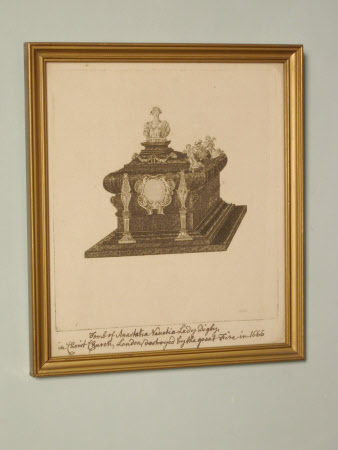
The Tomb of Lady Venetia Digby.
Christchurch within Newgate, London, destroyed in the Great Fire of London in 1666,
with the Copper Gilt bust
with the Copper Gilt bust
from a sketch by Aubrey - Aubrey notes the bust of Gilt bronze.
Basire c. 1786?
Image from National Trust, Berrington Hall.
There is a coloured illustration of the monument in the Digbiorium an Illuminated Pedigree compiled by Sir Kenelm Digby ( info - Dictionary London Tomb Sculptors).
There is a coloured illustration of the monument in the Digbiorium an Illuminated Pedigree compiled by Sir Kenelm Digby ( info - Dictionary London Tomb Sculptors).
______________________
Lady Venetia Digby (possibly) but more likely Lady Francis Cranfield.
Despite the doubt I include it because it is such a beautiful portrait.
Lewis Walpole Library
............................
Probably drawn after the miniature by Peter Oliver (now in the
Nationalmuseum, Stockholm [NMB 971 or 972]), that was kept by Horace Walpole in
the Breakfast Room at Strawberry Hill.
______________________________
Lady Venetia Digby.
by Henri Toutin.
Miniature Portrait of Lady Venetia Digby.
by Henri Toutin ( 1614 - post 1683).
Dated on the reverse 1637.
Posthumous enamel from an original by Peter Oliver.
Image courtesey Walters Art Museum.
....................................
Sir Kenelm and Lady Venetia Digby.
Isaac Oliver. (1589 - 1657).
After Anthony van Dyck.
Watercolour on Vellum.
Height 8.8 cms.
1632.
Image Courtesey Lewis Walpole Library.
This image had disappeared and has been newly inserted 28 Dec 2022.
_______________________________

Posthumous Portrait of Lady Venetia Digby (possibly as Prudence).
Anthony van Dyck.
National Portrait Gallery.
see - Franciscus Junius FF and his Circle, edited Rolf Hendrik Bremmer
see - Franciscus Junius FF and his Circle, edited Rolf Hendrik Bremmer
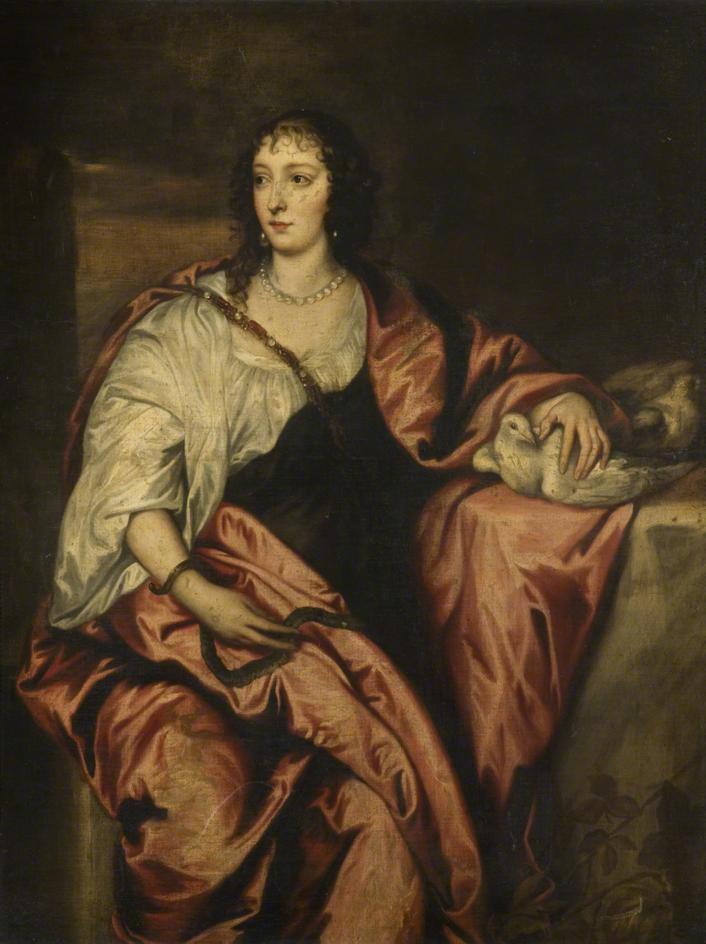
Lady Venetia Digby.
Anthony van Dyck.
Northampton Museum and Art Gallery

Lady Venetia Stanley on her deathbed.
Anthony van Dyck.
Dulwich Picture Gallery.
_____________________
For the lives of the Digbys see -
https://archive.org/stream/lifeofsirkenelmd00longuoft#page/n7/mode/2up
______________________________

Sir Thomas Bodley.
_____________________
For the lives of the Digbys see -
https://archive.org/stream/lifeofsirkenelmd00longuoft#page/n7/mode/2up
______________________________

Sir Thomas Bodley.
with vignettes of William Laud, William Herbert, 3rd Earl of Pembroke, John Selden and Sir Kenelm Digby.
Michael Burghers.
1654.
Engraving.
315 x 196 mm.
National Portrait Gallery.
By coincidence Sir Kenelm Digby is shown in the bottom left vignette this engraving.
Sir Kenelm left his library to the Bodlein.
See my previous blog entry regarding the portraits of Sir Thomas Bodley.
https://english18thcenturyportraitsculpture.blogspot.co.uk/2017/09/nicholas-stone-and-monument-of-thomas.html
___________________________________
Just for fun here are some further images of Sir Kenelm Digby.
My favourite fact? regarding Sir Kenulm Digby is that he was the inventor of the modern wine bottle.

Sir Kenelm Digby.
c. 1640.
Oil on Canvas.
117 x 91.7 cms.
National Portrait Gallery.
____________________________________

Sir Kenelm Digby.
Circle of Anthony van Dyck.
c. 1650.
127 x 101 cms.
oil on canvas.
image courtesy Philip Mould.
see -
http://www.historicalportraits.com/Gallery.asp?Page=Item&ItemID=345&Desc=Sir-Kenelm-Digby-%7C-Sir-Anthony-Van-Dyck,-Circle-of
The broken orrery perhaps indicating the tragic loss of his beloved wife.

Sir Kenelm Digby.
Robert van Voerst.
after van Dyck.
1636.
251 x 189 mm.
National Portrait Gallery.
Horace Walpole in Anecdotes ..... reports the original of this portrait at the house of Vice Admiral Sir J Stradling of Glamorganshire.
_________________________

Sir Kenelm Digby.
Richard Gaywood.
after van Dyck.
engraving.
107 x 83 mm.
1654.
National Portrait Gallery
_________________________________________

Sir Kenelm Digby.
after van Dyck.
Jacobus Houbraken.
1747.
342 x 238 mm.
National Portrait Gallery.
____________________________________
Catherine Bruce, Mrs William Murray (d. 1649).
Later Countess of Dysart.
Gilt Bronze Bust.
785 mm.
1637 - 39?
At Ham House, Surrey.
National Trust.
This bust has been attributed to both Besnier and Le Seuer but I would like to suggest that our friend Georg Larson might again be responsible.
Very poor Photograph.
Courtesy National Trust website.
One has to be thankful to the NT for publishing their collection on line but it really is about time that
they publish some half way descent photographs of their holdings.
It is also not possible to right click and save a larger image from their website - which I believe shows a meanness of spirit
.......................................
In a further misguided attempt to monetise their collection Alamy - a commercial photograph library have snaps of this bust available to purchase on line - see -
http://www.alamy.com/stock-photo-the-reverse-of-a-gilt-bronze-bust-of-katherine-bruce-mrs-murray-d1649-94490565.html
Catherine Bruce, Mrs William Murray (d. 1649).
Later Countess of Dysart.
Anthony van Dyck.
Oil on Canvas.
112 x 86.5 cms.
Ham House.
National Trust.
_________________________
Catherine Bruce Mrs William Murray (d. 1649).
Later Countess of Dysart.
Anthony van Dyck (1599 - 1641).
Oil on canvas.
135 x 108 cms.
Petworth House.
National Trust.
image from -
https://artuk.org/discover/artworks/catherine-bruce-d-1649-mrs-william-murray-219750
________________________________________
Anne of Austria.
Marble Bust ex Castle Howard from Sotheby's Treasures, Sale 8 July 2015
For a closer look at this sculpture see
http://bathartandarchitecture.blogspot.co.uk/2015/10/bust-of-anne-of-austria-from-castle.html
For Sotheby's Catalogue entry see
- http://www.sothebys.com/en/auctions/ecatalogue/lot.18.html/2015/treasures-l15303
Much more to follow on the two bronze busts of Lady Venetia Digby ..........
_______________________________


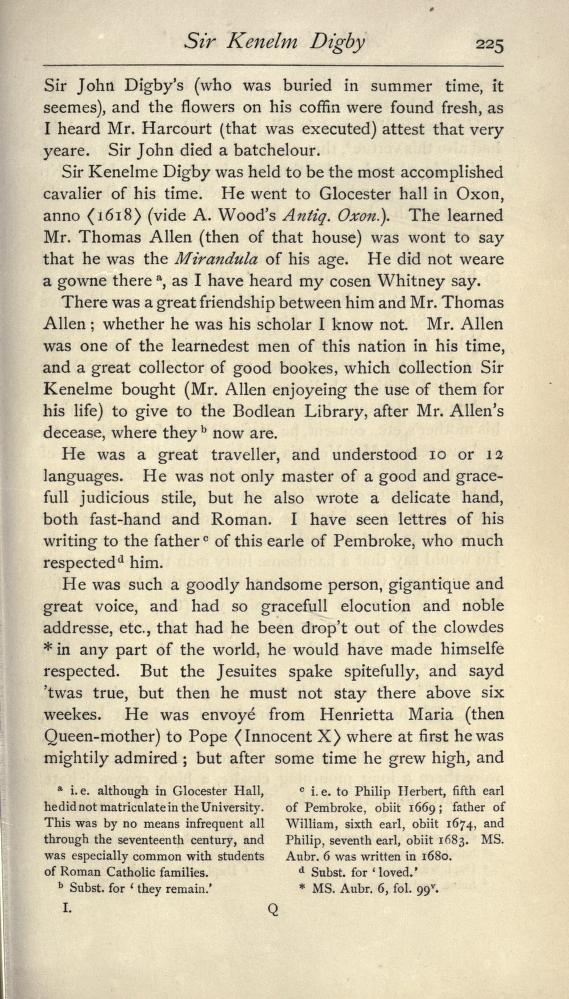






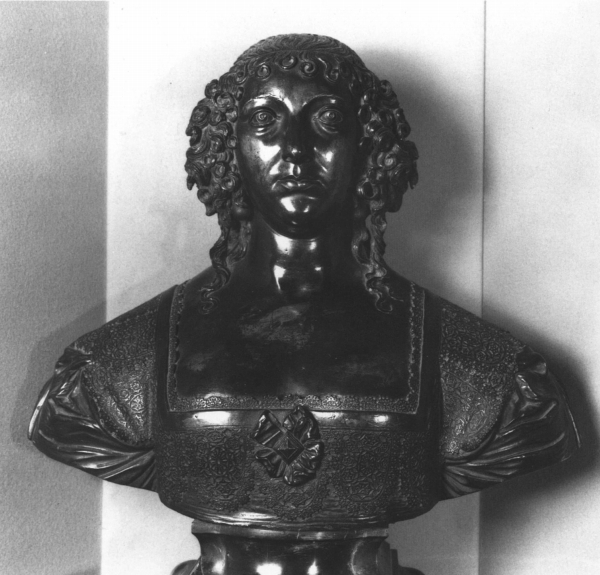











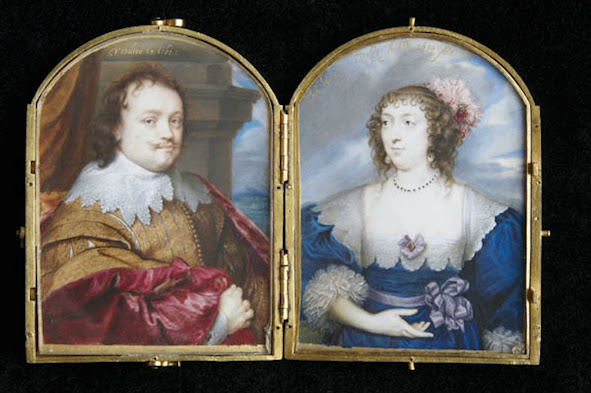









Excellent Blog Mr B,
ReplyDeleteI've been meaning to research Venetia Digby for ages.